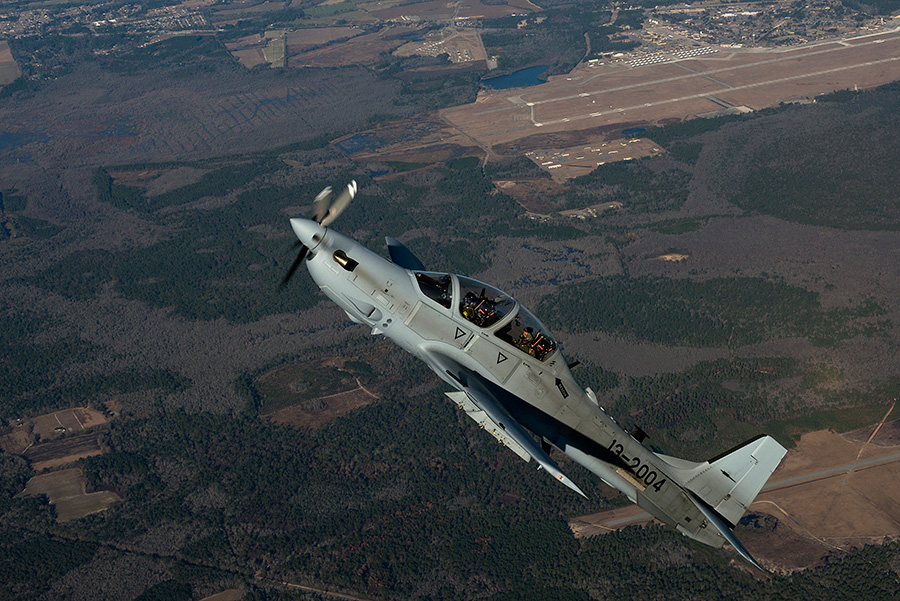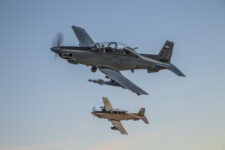
Sierra Nevada A-29 light combat aircraft
UPDATED: [Air Force comments on funding for the program; Rep. Rutherford comment.]
WASHINGTON: After a decade of dithering, and under threat from Congress to strip the program from its control, the Air Force today issued its long-awaiting request for proposal (RFP) for the Light-Attack Aircraft to Textron Aviation for the AT-6 and Sierra Nevada Corporation/Embraer Defense & Security for their A-29.
The Air Force will buy “two or three of both,” an Air Force spokeswoman told Breaking D today. The exact number, she said, has yet to be determined. According to the RFP, contract award is expected by the end of the year for the A-29 and in early 2020 for the AT-6.
UPDATE BEGINS. “Both the A-29 and AT-6 will be purchased with the existing $156M in procurement. The $156M includes $56.7 million in reprogrammed FY18 research, development, test, and evaluation funds and $100 million in FY19 procurement funds,” the Air Force spokeswoman told Breaking D yesterday.
“Of note, the AT-6 contract award will be via an Other Transaction Authority (OTA) and is contingent upon having RDT&E funding available through the FY20 appropriation,” she added. “The Air Force requested RDT&E funding in FY20 for continued experimentation. We are awaiting the final FY20 appropriation.” UPDATE ENDS.
Under the most recent scheme, presented to Congress with the fiscal 2020 budget request, the service has been planning to apply $100 million in fiscal year 2018 appropriated funding, and request reprogramming authority to realign $25.0 million in fiscal year 2019 appropriated funding so it can buy three each of the AT-6 and A-29 Light-Attack Armed Reconnaissance Aircraft (LAAR) platforms “to continue Phase 3 experimentation activities.” It also asked for $35 million in 2020 RTD&E for Phase 3.
Phase 3, ongoing since at least 2011, includes looking more closely at their use by allies, such as Afghanistan and Lebanon, who both own small numbers of the A-29, for counter-insurgency operations, and assessing how many the Air Force and allies might buy. (Sydney did a comparison of the two planes way back in 2012.)
“Our focus is on how a light attack aircraft can help our allies and partners as they confront violent extremism and conduct operations within their borders,” said Air Force Chief of Staff Gen. David Goldfein in the Air Force announcement. “Continuing this experiment, using the authorities Congress has provided, gives us the opportunity to put a small number of aircraft through the paces and work with partner nations on ways in which smaller, affordable aircraft like these can support their air forces.”
Air Combat Command will take charge of the AT-6 Wolverine planes at Nellis AFB in Nevada “for continued testing and development of operational tactics and standards for exportable, tactical networks that improve interoperability with international partners,” the announcement said.

Textron Beechcraft AT-6 Wolverine
Air Force Special Operations Command will use the A-29 Super Tucano at Hurlburt Field in Florida “to develop an instructor pilot program for the Combat Aviation Advisory mission, to meet increased partner nation requests for light attack assistance.”
Newly installed Air Force Secretary Barbara Barrett chimed in with one of her first official statements, saying: “Over the last two years, I watched as the Air Force experimented with light attack aircraft to discover alternate, cost-effective options to deliver airpower and build partner capacity around the globe. I look forward to this next phase.”
Goldfein said the effort will continue to examine a common architecture and intelligence-sharing network that can connect platforms, sensors and weapons and provide a digital network for light attack aircraft, according to the announcement, including the aircraft obtained by allies.
The House version of the 2020 National Defense Authorization Act included $35 million for the Air Force to continue its experimentation; but a group of Florida congressmen inserted an amendment with a significant caveat. If the Air Force did not allocate the funds to buy the six aircraft, all the monies would shift to Special Operations Command so they could make a direct purchase.
UPDATE BEGINS. Rep. John Rutherford, who spearheaded the amendment, told Breaking D this evening: “I am glad to see the Air Force move forward with the light attack program. I continue to believe this is a critical capability for our warfighters, and I look forward to working with the Air Force to expand the program.” UPDATE ENDS.
The Senate Appropriations defense subcommittee’s 2020 budget bill passed Sept. 10 recommends “$210 million for 6 O/A-X Light Attack Aircraft.” O/A-X refers to the Air Force’s rapid acquisition program for the six aircraft — for which the service did not request any 2020 funds.
A spokesman for Sierra Nevada said he couldn’t comment.
Textron’s vice president for Light Attack & Scorpion, Brett Pierson, told Breaking D that: “Textron Aviation Defense looks forward to fulfilling the Light Attack Aircraft (LAA) needs of our nation and its allies. … The U.S. Air Force purchase of two to three Beechcraft AT-6 Wolverine aircraft to test and develop operational tactics and standards for exportable, tactical networks at Nellis AFB will achieve these vital goals.”
Norway’s air defense priorities: Volume first, then long-range capabilities
“We need to increase spending in simple systems that we need a huge volume of that can, basically, counter very low-tech drones that could pose a threat,” Norway’s top officer told Breaking Defense, “so we don’t end up using the most sophisticated missile systems against something that is very cheap to buy.”


























